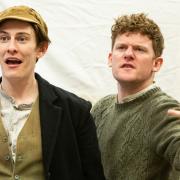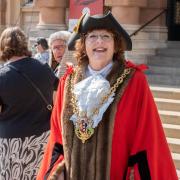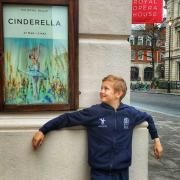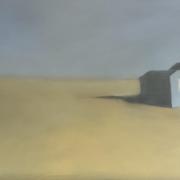Ross Gilfillan meets an engineer restoring the iconic World War II fighter plane in deepest Suffolk
Ross Gilfillan meets an engineer restoring the iconic World War II fighter plane in deepest Suffolk
Kenneth McGlashan flicked his gun switch to ‘live’ and lined up his attack on two marauding Messerschmitts, with no idea that he too was in immediate danger. Soldiers trapped on the Dunkirk beaches below watched as two more Me-109s closed on 19-year-old McGlashan’s Hurricane. He wrote later: “The first indication I had of anything going wrong was when the armour plate behind my head began ringing like an alarm clock.” Tracer shells crashed through the canopy, shattering Perspex and destroying his instrument panel. The cockpit began to fill with smoke. A second attack shut down his engine, sending the Hurricane plummeting earthwards. Fighting damaged controls, McGlashan pulled out of a fatal dive with seconds to spare and – with as much luck as skill – managed to crash land on the beach. As a shaken and wounded Ken McGlashan was helped away, he cast a last look at the shattered remains of his Hurricane. He never expected to see it again.
In a tiny village nestled in the gently rolling countryside near Lavenham, there is a pervading sense of peace, a deep tranquillity which is broken only by the calls of birds, the postman’s knock and the occasional throaty roar of a Rolls Royce Merlin engine, as a Hawker Hurricane fighter plane starts up for the first time in 70 years. Because nowhere in West Suffolk are appearances more deceptive that behind the doors of this picturesque farmstead, the unlikely home of Hawker Restorations, reputed to be the world’s finest restorers of the most successful fighter aircraft of the Battle of Britain.A substantial country house with a gravel driveway, a duck pond and some smart outbuildings belie the scale of the painstaking, highly skilled operations that go on here, day after day. There’s a door in an outbuilding which opens into what will probably be the reception area one day. Today, though, instead of desk, switchboard and a smartly dressed girl doing her nails, there’s a man creating a generous carpeting of sawdust with a screeching power vv tool and, just passing through, is a young woman in a boiler suit cheerfully shouldering an immense piece of wood like she’s off to help out at a crucifixion. From deeper into the building come the sounds of something being hammered into submission.I’m here to meet Tony Ditheridge, founder of Hawker Restorations and from what I’ve found out, a very interesting man. I know that this small, discreet establishment has rebuilt seven of the 12 Hawker Hurricanes now airworthy. There are three more under restoration in the workshop here now and another is expected soon. Tony’s nine-man company has already restored 21 WWI aeroplanes. Passing through a room full of classic racing cars – some of which are themselves being rebuilt – I enter a high ceilinged workshop dominated by the three Hurricanes currently under restoration. The planes are much bigger that I had imagined, even without their wings. One at least seems close to completion, the hand-stitched Irish linen coated in nitrocellulose dope stretched tautly over the timber-framed rear fuselage. I’ve seen pictures of what these machines look like before Hawker Restorations goes to work on them – the wrecked planes can arrive as “29 tea chests of bits – or as a nearly-complete but festering wreck.” How these boxes of odds and ends can possibly be transformed into the gleaming machines which stand here now is something I’m already struggling to understand.Inside a glass fronted office commanding a close view of the three Hurricanes in various stages of restoration, Tony Ditheridge extends a firm hand. I didn’t know what I expected but somehow, Tony seems to fit the bill. His youthful vigour and sandy hair belie his 63 years, while a paint-spattered shirt and forthright manner suggest a hands-on boss who makes things happen. Rather big things, it appears.I discover that he was born in Cambridge, went to a local secondary modern school and trained as an instrument tool fitter. But how, I wonder, did he end up in Suffolk (where he has lived for thirty years) spending his working life restoring Hurricanes and his days off racing 1959 Formula 1 BRMs at Goodwood?“When I was 19,” he explains, “the company I worked for got heavily involved with Cambridge University, who were developing a scanning electron microscope. Because of this, I had to switch to the electronics side.” He couldn’t know it then, but tool making and electronics would turn out to be key skills in the restoration of a Hawker Hurricane. Sourcing the planes would involve a lot of travel, and as an export sales executive for the specialised microscopes, Tony’s experiences in India, Africa and Latin America would later prove very useful too.His involvement in aeronautical engineering came about after he learned to fly and bought a Tiger Moth. He had sound, practical reasons for getting involved with the mechanics of flying. “Maintenance back then wasn’t so good,” he says, ruefully. “After I’d had a couple of engine failures, I decided I’d better do it myself.” It’s clear that Tony quickly made himself an expert in the field.At about this time, a friend of the legendary aviation pioneer Tommy Sopwith was looking for someone to restore a couple of Sopwith aeroplanes in time for Tommy’s 100th birthday celebrations. Tony landed the job and, employing two highly skilled craftsmen, one a metal worker and the other a woodworker, he started a company which specialised in restoring the aircraft of World War One.This project received a dramatic shot in the arm when the Chilean government decided to have built a Bristol M1-C monoplane.“The M1-C was a monoplane that our own government had deemed unsuitable for a combat role on the Western Front. They said it was too quick for short field landings but it’s more likely they just had no faith in monoplanes. At that time we had two Chilean battleships under construction. We commandeered the battleships and paid the Chileans with two squadrons of Bristol M1-Cs.”
If there was a Hurricane pilot and a Spitfire pilot in a pub, it would be the Spitfire pilot who left with the girl
The Chileans were interested in the aircraft because of the part that this model had played in the country’s aeronautical history. In December, 1918, a pilot named Lt Dagoberto Godoy of the Chilean Military School of Aviation flew from Santiago de Chile to Mendoza in Argentina, becoming the first man to make the hazardous aerial crossing of the Andes, and an instant national hero into the bargain. “The Chilean government wanted us to build a plane to celebrate this amazing feat,” Tony Ditheridge says. “But the trouble is, the person they had earmarked to build it had died in an aeroplane accident. By the time they had sorted it all out there was only four months to build the aeroplane, get it to Chile and fly it.”A build of this sort usually takes about two years, but working flat out, night and day, the job was completed and an operational M1-C was duly delivered to Chile in time for the celebrations. On their arrival in Chile, Tony and his team were feted as heroes themselves, but more significantly, AJD Engineering left the country with contracts to build three more WWI aircraft.Although the renamed Hawker Restorations continues to rebuild WWI planes, it’s the Hawker Hurricane for which they are justly renowned. Anyone who can rebuild this plane deserves recognition. The Hurricane is notoriously difficult to restore, its peculiarities meaning it takes twice as long to complete as a Spitfire. Many of the Hurricane’s million-plus components are engineered to hair’s breadth tolerances and the tiniest mistake can be hugely wasteful of man-hours and money. It is an unforgiving craft to rebuild. Tony’s entry into this risky business came about through another stroke of luck. “I had looked into restoring a Hurricane,” Tony says. “There were lots of Spitfires but very few Hurricanes. It made sense – I was trained as a toolmaker and this was a toolmaker’s plane.” But raising the enormous sum of money needed to fund this grand idea was another matter. Then New Zealand aviation entrepreneur Sir Tim Wallis stepped into the picture, with a request for Tony to rebuild an SE-5, the famous British WWI biplane. Pleased with the resulting restoration, he mentioned that he was looking for someone who could restore a wrecked Hawker Hurricane he had discovered in Russia.Tony knew just the man – but he warned that the cost would be enormous. Wallis agreed to commission the build after it was suggested that expenditure might be reduced if three Hurricanes were rebuilt simultaneously. And this was how Tony Ditheridge found himself in the business of rebuilding the aircraft which won the Battle of Britain. But just a minute – was it really the Hurricane which won the Battle of Britain? Doesn’t the Spitfire usually get credited with that?All too often, says Tony. He concedes that the Spitfire was sleekly glamorous and more photogenic than the thick-winged Hurricane and that the glamour often rubbed off on the pilots themselves. “If there was a Hurricane pilot and a Spitfire pilot in a pub, it would be the Spitfire pilot who left with the girl.” But the facts back his conviction that the real glory was earned by the Hurri. During the Battle of Britain, the RAF had 32 Hurricane squadrons and only 19 squadrons of Spitfires. Employed to attack bombers while the Spitfires took on the Messerschmitts, or as stable gun platforms for strafing runs and tank busting, Hurricanes nevertheless accounted for 60% of British victories in the air. Partly, this was because the aircraft had a tighter turning circle than either its main rival, the Spitfire, or its main opponent, the Me-109. The Hurricane’s cork-screw dive up-ended the tables on many a Messerschmitt’s attack. Irascible fighter ace Douglas Bader loved it for just that reason: “It was strong, highly manoeuvrable and could turn inside the Spitfire and the Me 109.”A plane worthy of restoration, then, and perhaps that’s a comfort for restorers as they begin their epic task of identifying, cleaning and testing the enormous piles of rusting scraps, tangled wires and thousands of nuts and bolts which – some two years down the line – will become part of a pristine, airworthy aircraft. After so much care and patience has been lavished on a project, completion can evoke mixed feelings. Tony Ditheridge compares it to seeing your child being born, growing up and going out into the world. With only seven staff working on site and two sheet metal workers based in a shed in their garden at Bournemouth, everyone has to lend a hand with whatever needs doing next. As I talk to Tony beneath the uncowled Merlin engine of Hurricane G-ROBT, the girl I saw in reception, who ostensibly does the accounts and updates the website, walks by with the other piece of her cross. Jenny has recently returned from Egypt, where she’s been discussing the building of an historic float plane. Everyone appears to go the extra mile – perhaps it’s for Tony, perhaps it’s because they enjoy and take real pride in their work. Someone who would have been especially pleased with the results of their labour is Ken McGlashan. The ex-Hurricane pilot, who became a squadron leader before emigrating to Australia, saw the plane prior to its restoration and his own death. It was the first time he’d set eyes on the machine – the one we’re standing under right now – since he abandoned it on the beaches at Dunkirk in 1940.


























